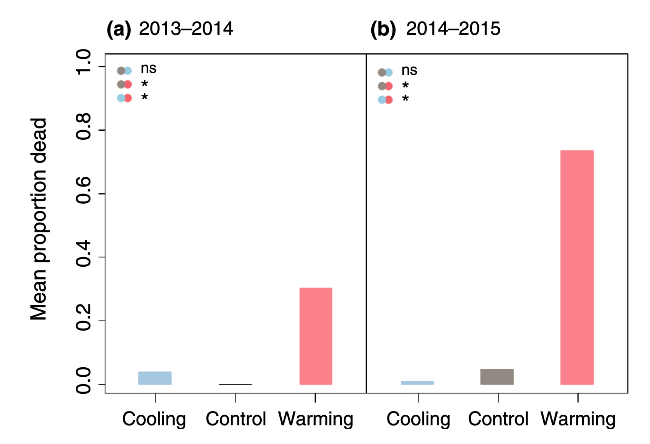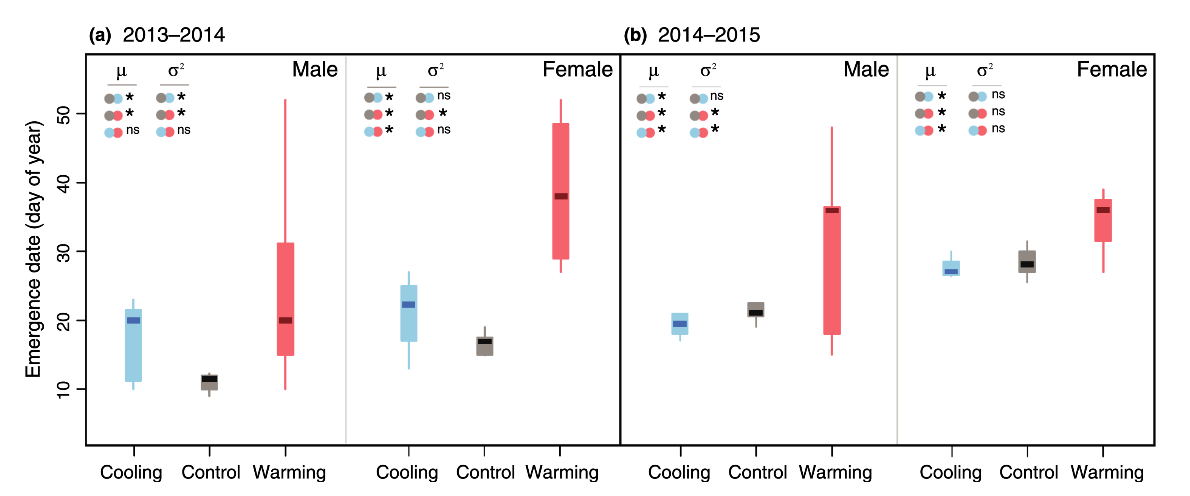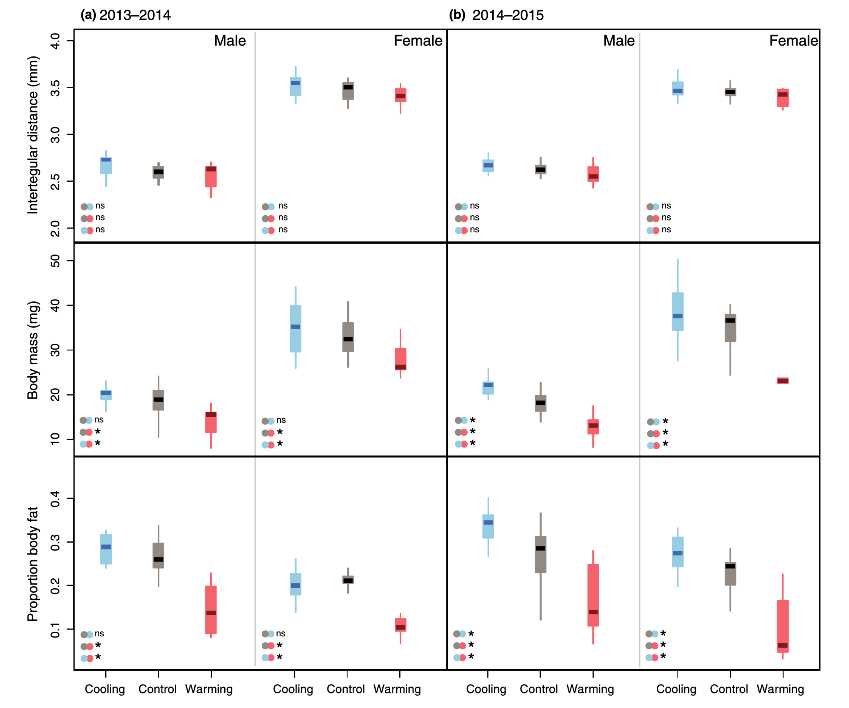Climate change is decreasing mountain pollinating insects
by Mark L. Miller
by Mark L. Miller
About 35% of the world’s crop production and 87% of the world’s leading crop production is dependent on pollinators. That is worth between US$235 billion and US$577 billion (FAO, 2015).
Nobody reasonable would want a decrease of pollinators.
Yet, a long-term study on honeybees and beekeepers showed that the size of honeybee colonies and the number of beekeepers has decreased in most of EU countries between 1985 and 2005 (Figura 1).
The exact causes of pollinating insects decline are still unknown, but they are linked to 1) Habitat loss, fragmentation and modification; 2) Landscape Diversity; 3) Farming and grazing practices; 4) Pesticides; 5) Introduced species; 6) Urban development; 7) Fires; 8) Climate change. Surely, the decline may also be an effect of multiple causes.
While habitat loss, resulting in less food and shelter for pollinating insects, seems to be accepted as the most important cause of decline, there is still a lot of lack of knowledge about the impact degree of the other causes. For example, it is difficult to quantify how the diversity and floral resources of a landscape affect the distribution and diversity of pollinating insects (Nicholls & Altieri, 2012; Potts, 2010). Furthermore, pesticides, and especially neonicotinoids, harm the health of pollinating insects at unknown degree (Hadlik et al. 2016). New studies, however, revealed that invasive species can spread viruses and diseases that affect bees (Briggs, 2018) and climate change can alter the behavior of bees and other pollinating insects (Morris, 2018; Fessenden, 2015).
For mountain areas, climate change definitely plays an important role.

Figure 1 — Honeybee colonies and beekeepers decline from 1965 to 2005 (Potts et al. 2010).
Source: Paul CaraDonna
A two-year-study of the North Carolina State University investigated on the link the between climate change and pollinating insects decline. That is, the adaptation of the blueberry Mason bee, a native solitary bee in Western US and Northern Mexico and primary pollinator of wild manzanita shrubs, to a different phenology (i.e. earlier snow melt and flower blooming).
To conduct the experiment, three types of nesting environments in Arizona’s Santa Catalina Mountains were set up and temperatures of the nests were manipulated to simulate past, present and future climates .
One third of the nests were painted black to absorb more radiant heat, thus simulating a future climate predicted for the years 2040 to 2099, one third was painted with a white, reflective, cooling treatment to simulate climate in the 1950s, one third was painted with a transparent paint and represented the control nest.
The experiment included 90 nests total, each housing between 2 and 15 bees, and was run twice during two consecutive seasons.
Results revealed that during the 2013–2014 season, 163 bees emerged from 32 nests, amounting to 58, 54 and 21 bees from the control, cooling and warming treatments, respectively. During the 2014–2015 season, 131 bees emerged from 55 nests, amounting to 71, 79 and 13 bees from the control, cooling and warming treatments, respectively. This implies that 35% of the native blueberry Mason bee in nests predicting future climates died in the first year and 70% in the second year (Figura 2).

Figure 2 – Mortality of the Mason bee in three temperature treatments from 2013–2014 and 2014–2015. Bars represent the mean proportion of dead bees per nest for each treatment. Asterisks represent significant differences at p < 0.05, and “ns” no statistical difference (CaraDonna et al. 2018).
During the two years study bees experienced the altered environments from larval development, through metamorphosis and adult diapause. Bees in nests simulating past and current climates woke up from diapause and emerged after 10–15 days in February, which is normal. Bees in nests simulating future climates underwent multiple disturbing changes. Their mortality rates were remarkably high, and they emerged from diapause after 50 days (Figure 3).

Figure 3 – Adult emergence phenology for Mason bee males and females in three temperature treatment in 2013–2014 and 2014–2015 (CaraDonna et al. 2018).
Furthermore, bees in nests simulating future climates emerged with smaller bodies and lower body fat content (Figure 5). This did not depend on the bee sex.

Figure 4 – Response of linear body size, body mass and adult fat content of the Mason bee to temperature manipulation (CaraDonna et al. 2018).
Bees did not emerge from all nests for several reasons: because of mortality that occurred during the temperature experiment, because of parasitism that occurred during nest construction prior to nest transfer into the experiment, because bees left some nests vacant during nest construction (as defense against parasitism, e.g. Tepedino, or some combination thereof).
The mortality increase result indicates that the projected temperatures can push bees to their physiological limits and may determine local extinctions in the warmer parts of Mason bee’s range.
The diapause prolongation result may be related to the body size and fat loss result. Indeed, it is likely that warmer temperatures prolong bees’ diapause and increase their metabolism while they dormant. This means that bees burn their fat reserves more quickly. Lower fat reserves at diapause emergence reduces their chances to resist storms and therefore successfully reproduce. Furthermore, emerging later from diapause means that there are fewer available floral resources and it is more stressful to find mates. All this has implications for the stability of the Mason bee population.
Consequently, Mason bees could move further up the mountains to cooler climates in the future. But this will take them away from the manzanita shrubs, which are their main source of food. This will also affect manzanita and other plants that rely on them for pollination. As a matter of fact, it is unlikely that bee and pollinated plants will migrate upwards simultaneously. This will result in a lose-lose situation for both bees and pollinated plants due to their interdependence (source of food / pollination).

(Source: Getty Images).
While Arizona’s Mason bees have the possibility to move further up the mountains, some other pollinators will encounter more restrictions when moving to higher elevations or to northern areas in search for cooler climates (Kerr, 2015). Looking at American and European bumblebees, they are shifting the southern limit of their ranges towards north by as much as 300 km in some cases. However, the northern limits of the bumblebee ranges fail to extend to more northern into territories that are now habitable for them due to climate change. This leads to an overall range and habitat contraction.
The effects of habitat contraction and loss due to climate change is even more pronounced for native mountain pollinating insects. Besides suffering from the loss of plants from which they gather nectar and pollen, they may be trapped without a place to go as their habitat becomes warmer (USGS, 2018).
A long-term study in the pristine Rocky Mountains of Colorado revealed a 50% bumblebee decline after 17-years of monitoring. For nearly two decades, researchers compared the fruiting rate of glacier lilies that were artificially pollinated by hand and those that were left to be pollinated naturally by bumblebee. Over time, the fruiting rate of the naturally pollinated plants declined relative to the hand-pollinated plants. The cause may be related to climate change: glacier lilies bloom earlier in spring (up to a month earlier than in 1995) but maintain their overall growing season of three months. This forces bumblebees to break out from their diapause and visit flowers earlier. Apparently, this anticipation is not so straightforward since the decline of naturally pollinated lilies is remarkable. Either bumblebees have yet not adapted their diapause to the earlier blooming or have but cannot visit flowers at high frequency due to the harsher weather in early spring (Thomson, 2010). In either case the decline is statistically significant and has no correlation with pesticides, habitat loss or intensive farming practices. This proves that climate change, especially in mountain areas, notably contributes to pollinating insects’ decline.
Briggs, H. (2018). New clues to decline of bees and other pollinators. [online] Available at: https://www.bbc.com/news/science-environment-43200277 (Accessed 2019.01.21).
CaraDonna, P.J. et al. (2018). Experimental warming in the field delays phenology and reduces body mass, fat content and survival: Implications for the persistence of a pollinator under climate change. Funct Ecol. 2018; 00:1–12.
Food and Agriculture Organization of the United Nations. (2018). The importance of bees and other pollinators for food and agriculture. [online] Available at: http://www.fao.org/3/I9527EN/i9527en.PDF (Accessed 2019.03.03).
Fessenden, M. (2015). How Climate Change is Messing with Bees. [online] Available at: https://www.smithsonianmag.com/smart-news/how-climate-change-messing-bees-ability-pollinate-180956523/ (Accessed 2019–01–21).
Hadlik, M. et al. (2016). Exposure of native bees foraging in an agricultural landscape to current-use pesticides. Science of the Total Environment. USGS. [online] Available at: https://www.sciencedirect.com/science/article/pii/S0048969715308937?via%3Dihub (Accessed 2019.03.03).
Kerr, J.T. (2015). Climate change impact on bumblebees convergence across continents. American Association for the Advancement of Science. [online] Available at: https://www.uvm.edu/rsenr/taylorricketts/documents/Kerr.etal2015Science-2015-Kerr-177-80.pdf (Accessed 2019.03.03).
Morris, A. (2018). Climate change linked to bee decline. [online] Available at: https://news.northwestern.edu/stories/2018/june/climate-change-linked-to-potential-population-decline-in-bees/ (Accessed 2019.01.21).
Nicholls, C.I. and Altieri, M.A. (2012). Plant biodiversity enhances bees and other insect pollinators in agroecosystems. A review. Agronomy for Sustainable Development 33 (2): 257–274.
Potts, S.G. et al. (2010). Declines of managed honey bees and beekeepers in Europe. Journal of Apicultural Research. [online] Available at: https://www.tandfonline.com/doi/pdf/10.3896/IBRA.1.49.1.02 (Accessed 2019.03.03).
Potts, S.G. et al. (2010). Global pollinator declines: trends,impacts and drivers. Trends in Ecology and Evolution Vol.25 №6. [online] Available at: https://nature.berkeley.edu/kremenlab/wp-content/uploads/2014/03/Global-pollinator-declines.pdf.
Thomson, J.D. (2010). Flowering phenology, fruiting success and progressive deterioration of pollination in an early-flowering geophyte. Phil. Trans. R. Soc. B(2010)365, 3187–3199
USGS. (2018). Native Bee Status and Vulnerability to Climate Change in National Parks. [online] Available at: https://www.usgs.gov/centers/pwrc/science/native-bee-status-and-vulnerability-climate-change-national-parks?qt-science_center_objects=9#qt-science_center_objects (Accessed 2019–01–21).
GreenMarked è più di un blog ambientale. Pubblichiamo articoli fatti in casa, organizziamo eventi di educazione ambientale, progetti di riforestazione e campi di digital detox.
Telegram: @greenmarked
LinkedIn: @greenmarked
Instagram: @greenmarked.it
Facebook: @greenmarked.it
Twitter: @greenmarked

 The cultural capital of apple growers in Upper Vinschgau
The cultural capital of apple growers in Upper Vinschgau 